Commodities Boom to be Driven by the Urbanisation of 1 Billion More People
Commodities / Demographics May 18, 2013 - 03:11 PM GMTBy: Richard_Mills
 Many, many years ago during a lengthy argument with a friend he told me to 'give it a doubt' - he meant I was wrong.
Many, many years ago during a lengthy argument with a friend he told me to 'give it a doubt' - he meant I was wrong.
The herd is convinced the commodities boom is over. Doom and gloom, the sky is falling, the bears argument sounds convincing - growth has stopped, economies are slowing. Looking at the TSX.V's performance (most of the world's mineral exploration firms call the Venture Exchange home) it's as if people are convinced the need to search for, develop and mine new mineral deposits is over.
According to Bloomberg the U.S. economy may cool to a 1.6 percent pace in the second quarter, after growing at a 2.5 percent rate in the first three months of 2013.
U.S. industrial production fell by the most in eight months - a gauge of factories in the New York area fell to minus 1.4 this month from 3.1 in April.
"The drop in factory output, which accounts for more than 70 percent of industrial production, was broad-based and in keeping with data earlier this month that showed factory payrolls failed to expand last month.
Industrial capacity utilization, a measure of how fully the nation's mines, factories and utilities are deploying their resources, dropped sharply from a more than 4-1/2 year high." Reuters,Factory, wholesale price data flag economy's woes
Manufacturing has been hit hard by the $85 billion in across the board spending cuts - the 'fiscal cliff' that started in March. U.S. GDP growth is predicted at 1.9 percent for 2013.
There's a record six quarter recession in Europe, GDP growth there is expected to contract by 0.1 percent, GDP growth for Japan is predicted at 0.8 percent for 2013.
Sounds ominous, it's obvious the commodities boom has gone bust and economic growth has disappeared.
Give it a doubt.
In the Latin American and Caribbean region 2013 GDP growth is predicted at 3.5 percent, in the East Asian and Pacific region growth is predicted at 7.9 percent. China's GDP growth outlook for 2013 is 8.6 percent while India's outlook clocks in at 6.1 percent.

Reddit.com
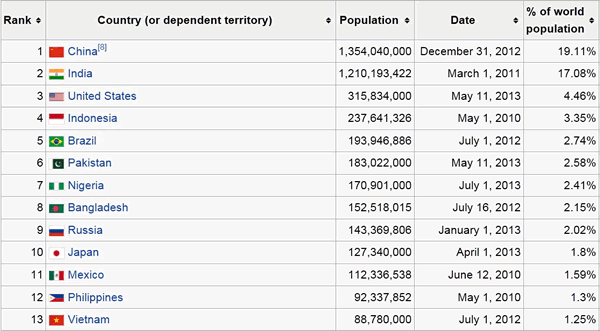
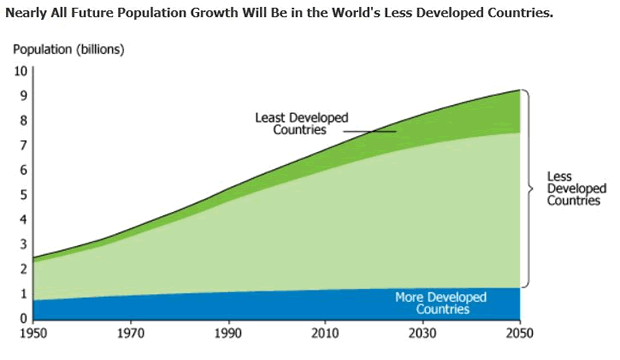
Prb.org
Developing countries account for 97 percent of population growth because of the dual effects of high birth rates and young populations.
Below is list of the twenty most populous countries in the year 2050:
- India - 1,692,008,000
- China - 1,295,604,000
- United States - 403,101,000
- Nigeria - 389,615,000
- Indonesia - 293,456,000
- Pakistan - 274,875,000
- Brazil - 222,843,000
- Bangladesh - 194,353,000
- Philippines - 154,939,000
- Democratic Republic of the Congo - 148,523,000
- Ethiopia - 145,187,000
- Mexico - 143,925,000
- Tanzania - 138,312,000
- Russia - 126,188,000
- Egypt - 123,452,000
- Japan - 108,549,000
- Vietnam - 103,962,000
- Kenya - 96,887,000
- Uganda - 94,259,000
- Turkey - 91,617,000
A new report from the McKinsey Global Institute, Urban world: Cities and the rise of the consuming class, finds that:
- The 600 cities making the largest contribution to a higher global GDP - the City 600 - will generate nearly 65 percent of world economic growth (worth $30 trillion) by 2025.
- One billion new people will enter the global consuming class by 2025.
- Cities are expected to build floor space equivalent to 85 percent of today's space - an area the size of Austria. The urban building boom will require cumulative investment of $80 trillion.
- Nearly an 80 billion cubic meter increase in municipal water demand is expected by 2025.
- Over 2.5 times today's level of port infrastructure is needed to meet rising container shipping demand.
- Consumption and capacity building in the developing world are already straining the global supply of capital and natural resources.
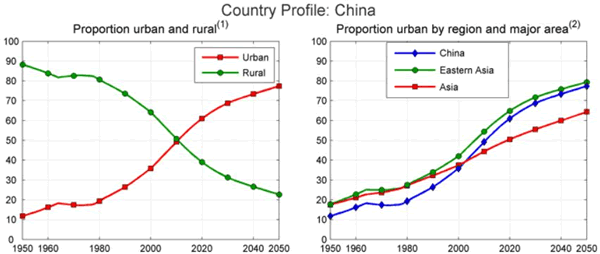
With a current population of 4.3 billion, Asia will add about one billion people to the global population by 2050 - most will live in urban areas.
Under new Chinese leadership China is going to spend a massive 40 trillion yuan to urbanize the rural outskirts of some 270 cities - China estimates that 400 million additional people will move to its cities in the next 30 years.
By 2025, nearly 2.5 billion Asians will live in cities, accounting for almost 54 percent of the world's urban population.
India and China alone will account for more than 62 percent of Asian urban population growth and 40 percent of global urban population growth from 2005 to 2025.
It took India nearly 40 years to add 230 million urban residents, but it will take only half that time to add another 250 million.
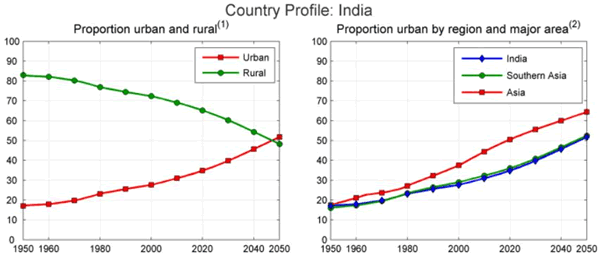
Africa's population can be expected to at least double from 1.1 billion to about 2.3 billion by 2050 - most will live in urban areas.
Africans, on a per capita basis, are richer than Indians and a full dozen African states have higher gross national income per capita than China.
"The incomes of these new consuming classes are rising even faster than the number of individuals in the consuming classes. This means that many products and services are hitting take-off points at which their consumption rises swiftly and steeply. By 2025 urban consumers are likely to inject around $20 trillion a year in additional spending into the world economy. Catering to the burgeoning urban consumer classes will also require a boom in the construction of buildings and infrastructure. We estimate that cities will need annual physical capital investment to more than double from nearly $10 trillion today to more than $20 trillion by 2025, the lion's share of which will be in the emerging world."
~McKinsey Global Institute, Urban World: Cities and the rise of the consuming class
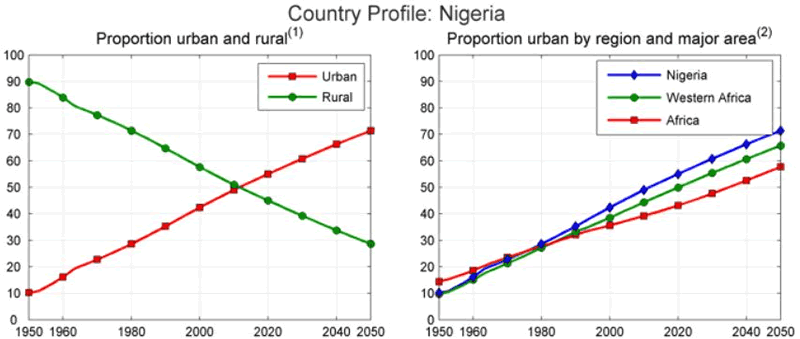
Today Africa has 15 percent of the world's population and by 2050 one in every four people on the planet will be African - by 2027 Africa will have more people than does China or India.
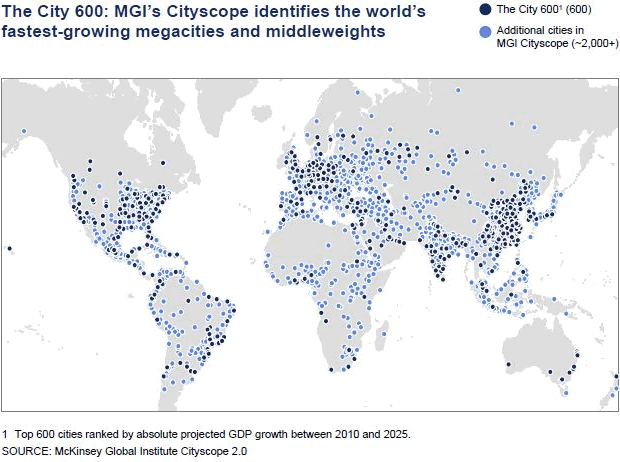
From the World Bank comes the following:
Cities, large and small, are at the heart of a fast changing global economy -- they are a cause of, and a response to world economic growth.
The world's cities are growing because people are moving from rural areas in search of jobs, opportunities to improve their lives and create a better future for their children.
This is the first time in human history that the majority of the world's population lives in urban areas:
- 60% of all people will live in cities by 2030. In 1800, only 2% of people lived in cities and towns, in 1950 only 30% of the world population was urban (it has been predicted elsewhere that by 2050, 64.1% and 85.9% of the developing and developed world respectively will be urbanized).
- Almost 180,000 people move into cities each day.
- 60 million people move into cities each year in developing countries. This rate of movement will continue for the next 30 years
Another report from the McKinsey Global Institute says the world will need to spend $57 to $67 trillion between now and 2030 - that's not counting what it will cost to upgrade networks to get them to where they need to be today nor do the costs factor in climate change.
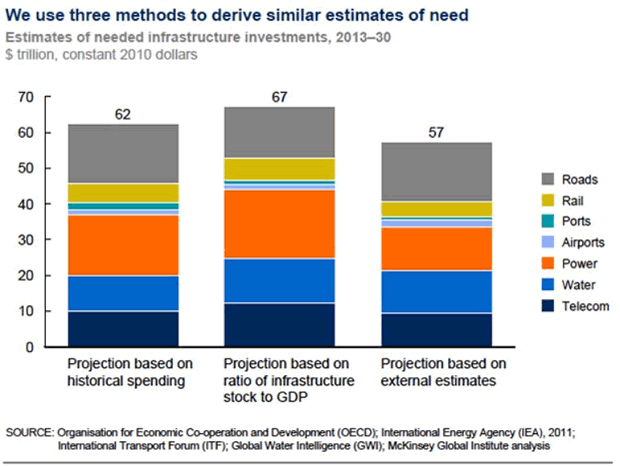
Representing 43 percent of the world's population and 17 percent of trade the BRICS - Brazil, Russia, India, China and South Africa - have agreed to create a development bank to provide initial funding for infrastructure projects worth $4.5 trillion. Other developing countries will eventually be invited to join the bank, India has offered $50bn of seed capital to get the initiative started.
What about the present day global infrastructure deficit, what about the deficit that already exists never mind the trillions of dollars and massive resources needed for newly minted and future urbanites, the exploding consumer class?
Back to the present
The news isn't good...
Infrastructure is the physical systems - the roads, power transmission lines and towers, airports, dams, buses, subways, rail links, ports and bridges, power plants, water delivery systems, hospitals, sewage treatment, etc. - that are the building blocks, the Legos, that fuel a countries, a cities or a community's economical, social and financial development.
Cairo, Los Angeles, Beijing, Paris, Moscow, Mumbai, Tokyo, Washington, Sao Paulo: Each major city has its own story of electricity, transportation, or water systems in crisis. Although the circumstances vary from one urban area to the next, they all have one thing in common: The critical infrastructure that is taken for granted by both their citizens and their government leaders is technologically outdated, woefully inadequate, increasingly fragile, or all of the above. In some cities, the quality of water, power, and transportation infrastructure is noticeably declining. In others, it was never very good to begin with. And few cities have enough of it to meet future needs." Lights! Water! Motion!, strategy-business.com
There is an undeniable, an unarguable connection between the quality of a countries economic competitiveness and its infrastructure. Yet study after study shows the global economy currently running an infrastructure deficit of anywhere from US$ 40 trillion to $70 trillion.
The World Economic Forum's Positive Infrastructure Report finds that the world faces a global infrastructure deficit of $2 trillion per year over the next 20 years.
The American Society of Civil Engineer's (ASCE) New Report Card concludes that to raise the grades, from the current D+, and get U.S. infrastructure to an acceptable level, a total investment of $3.6 trillion is needed by 2020. Currently, about $2 trillion in infrastructure spending is projected.
A major new Canadian study by the Federation of Canadian Municipalities (FCM), showed that a significant amount of municipal infrastructure ranks between "fair" and "very poor." The report provides an assessment of the condition of four primary asset categories of municipal infrastructure: drinking-water systems, wastewater and storm water networks, and municipal roads. The replacement/upgrade cost of just these assets total $171.8 billion.
Conclusion
Add it all up, the global infrastructure deficit, today's and tomorrow's, the incredible amount of urbanization and population growth still to take place, the addition of a billion and more consumers, piece it altogether and you have to see it equals an enormous demand that's going to be placed on the world's finite supply of increasingly conflicted mineral resources.
The scale of resource use is unprecedented in magnitude, the number of people we're talking about is well over a billion - all to be new urbanized consumers by 2025. The world's population is suppose to number 9-10 billion (another 2-3 billion in just a few decades) by 2050 increasing even further the demand for the globes resources.
Bull markets climb a wall of worry. Today the dollar is up and commodities are down but more money creation, on a massive scale, an unprecedented level, a "you ain't seen nothing yet' kind of scale is both necessary and coming - central bank monetary policies have been an abysmal failure, time for governments to step in with fiscal policy geared toward generating jobs from urbanization/infrastructure programs.
This is extremely bullish for minerals and other commodities.
Are minerals, and the mining of, on your radar screen?
If not, maybe it should be.
By Richard (Rick) Mills
If you're interested in learning more about the junior resource and bio-med sectors please come and visit us at www.aheadoftheherd.com
Site membership is free. No credit card or personal information is asked for.
Richard is host of Aheadoftheherd.com and invests in the junior resource sector.
His articles have been published on over 400 websites, including:
Wall Street Journal, Market Oracle, USAToday, National Post, Stockhouse, Lewrockwell, Pinnacledigest, Uranium Miner, Beforeitsnews, SeekingAlpha, MontrealGazette, Casey Research, 24hgold, Vancouver Sun, CBSnews, SilverBearCafe, Infomine, Huffington Post, Mineweb, 321Gold, Kitco, Gold-Eagle, The Gold/Energy Reports, Calgary Herald, Resource Investor, Mining.com, Forbes, FNArena, Uraniumseek, Financial Sense, Goldseek, Dallasnews, Vantagewire, Resourceclips and the Association of Mining Analysts.
Copyright © 2013 Richard (Rick) Mills - All Rights Reserved
Legal Notice / Disclaimer: This document is not and should not be construed as an offer to sell or the solicitation of an offer to purchase or subscribe for any investment. Richard Mills has based this document on information obtained from sources he believes to be reliable but which has not been independently verified; Richard Mills makes no guarantee, representation or warranty and accepts no responsibility or liability as to its accuracy or completeness. Expressions of opinion are those of Richard Mills only and are subject to change without notice. Richard Mills assumes no warranty, liability or guarantee for the current relevance, correctness or completeness of any information provided within this Report and will not be held liable for the consequence of reliance upon any opinion or statement contained herein or any omission. Furthermore, I, Richard Mills, assume no liability for any direct or indirect loss or damage or, in particular, for lost profit, which you may incur as a result of the use and existence of the information provided within this Report.
Richard (Rick) Mills Archive |
© 2005-2022 http://www.MarketOracle.co.uk - The Market Oracle is a FREE Daily Financial Markets Analysis & Forecasting online publication.



